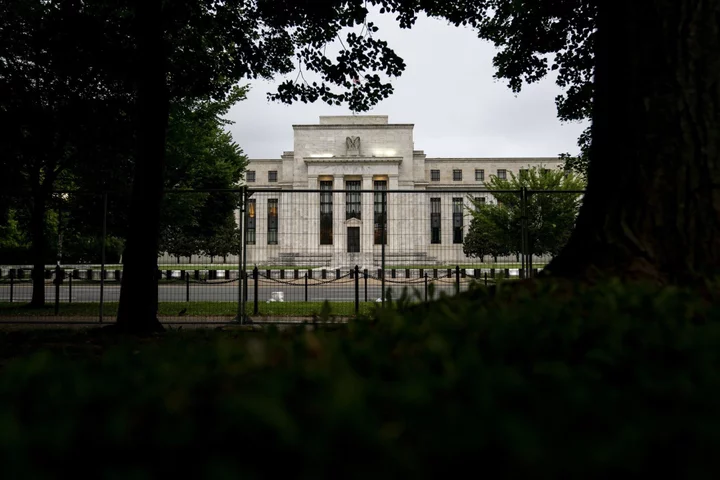A Federal Reserve report warned that banks’ concerns about slower growth could lead them to make fewer loans, accelerating an economic downturn, and highlighted commercial real estate as an area of heightened risk that will draw more scrutiny from bank examiners.
The US central bank’s financial stability report released Monday is the first since four regional lenders collapsed. The episodes prompted weeks of wild trading in bank stocks and forced regulators to take a series of extraordinary steps that included backstopping all depositors at Silicon Valley Bank and Signature Bank.
“Concerns about the economic outlook, credit quality, and funding liquidity could lead banks and other financial institutions to further contract the supply of credit to the economy,” the Fed said in its report. “A sharp contraction in the availability of credit would drive up the cost of funding for businesses and households, potentially resulting in a slowdown in economic activity.”
The report, which isn’t a forecast, described bank funding as relatively stable on the whole, though it pointed to numerous liquidity risks in other corners of the financial markets.
“Overall, domestic banks have ample liquidity and limited reliance on short-term wholesale funding,” the report said. “Structural vulnerabilities remained in short-term funding markets. Prime and tax-exempt money market funds, as well as other cash investment vehicles and stablecoins, remained vulnerable to runs.” Life insurers face elevated liquidity risks, as they increased holdings of risky and illiquid assets.
Office Space
The report said the shift to telework could reduce demand for office space and lead to a downturn in the value of city retail properties. “The magnitude of a correction in property values could be sizable and therefore could lead to credit losses by holders” of commercial real estate debt.
The Fed said that in response to concerns around commercial property debt, it has stepped up monitoring of CRE loan performance and expanded examination procedures for banks with significant CRE concentration risk.
The central bank has raised interest rates at the fastest pace since the 1980s as it tried to catch up to surging inflation that it was slow to forecast and respond to. In the middle of last year, the Fed accelerated rate hikes with a string of four 75-basis-point moves. The overnight lending rate stands at 5% to 5.25%, following a quarter-point increase last week.
Read more: Powell Opens Door to June Pause, Stresses Inflation Job Not Done
The jump in rates has stung the banks with losses in their bond portfolios, creating fragility in the banking system. Silicon Valley Bank, which was directly supervised by the Fed, failed March 10 after a deposit run.
The Fed said in a lengthy review of the collapse that the bank failed its own liquidity stress tests, while its examiners didn’t recognize the risk of “critical deficiencies in the firm’s governance, liquidity, and interest rate risk management.”
Overall, the report had a relatively sanguine view of risks facing the banking sector so long as the economy continues to grow. It noted that the credit quality in the economy “remained strong” though delinquency rates in some segments such as autos and credit cards have increased.
Risk Areas
The report’s framework focuses on four areas of risk, such as asset valuations and funding risk.
Asset Valuations: Property valuations remained elevated. “In residential real estate, valuations remained near all-time highs despite weakening activity and falling prices in recent months,” the report said. “Valuations in the commercial segment also remained near historical highs even though price declines have been widespread.”
Borrowings by businesses and households: Business debt stayed at high levels. Still, interest coverage ratios were high, supported by earnings growth. The report said an economic downturn could weaken debt-servicing capacity at firms. Household debt levels were modest.
Leverage within the financial sector: The Fed said the largest banks have adequate capital. “Notwithstanding the banking stress in March, high levels of capital and moderate interest rate risk exposures mean that a large majority of banks are resilient to potential strains from higher interest rates,” the report said.
Funding risks: The Fed said that in 2020 and 2021, banks added nearly $2.3 trillion in securities to their balance sheets, primarily fixed-rate US Treasury securities and agency-guaranteed mortgage-backed securities, most of which were placed in their available-for-sale and held-to-maturity securities portfolios. But as rising interest rates began to result in lower bond prices, banks had declines in fair value of $277 billion in AFS portfolios and $341 billion in HTM portfolios, the report said.
Lower marks on a securities portfolio are risky for banks if they are forced to sale to meet deposit outflows. The report said, however, that “domestic banks have ample liquidity and limited reliance on short-term” runnable deposits.
(Updates with risks to commercial real estate credit starting in sixth paragraph)

